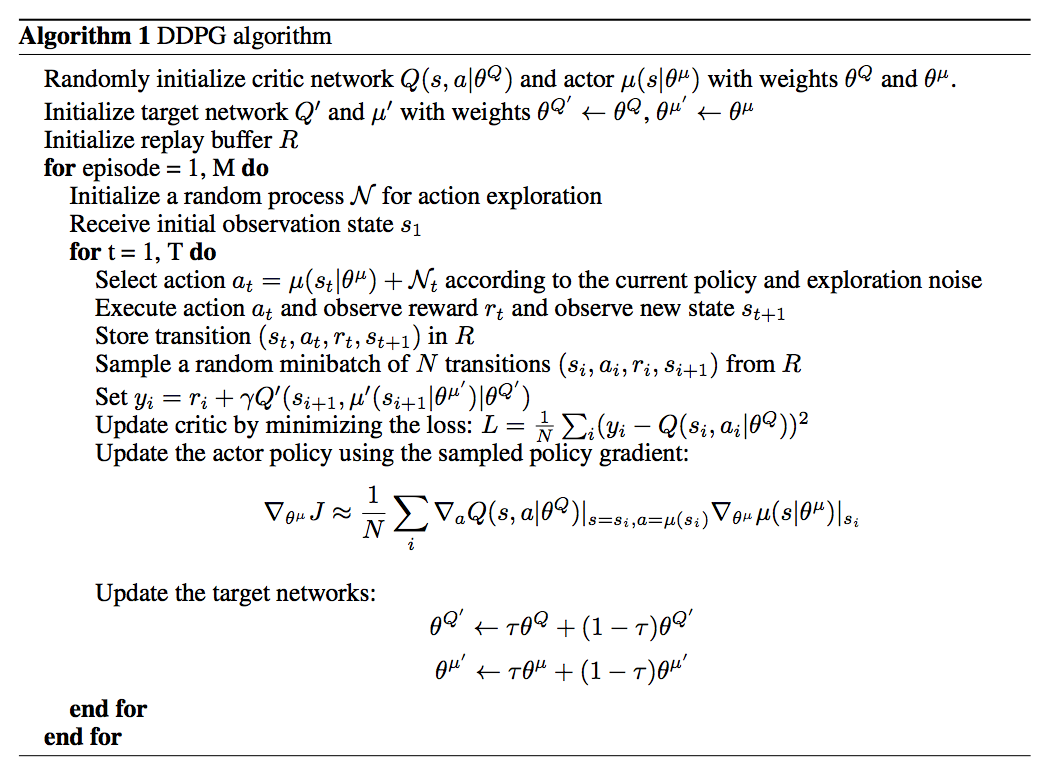深度增强学习--DDPG
ddpg输出的不是行为的概率, 而是具体的行为, 用于连续动作 (continuous action) 的预测

代码实现的gym的pendulum游戏,这个游戏是连续动作的

- """
- Deep Deterministic Policy Gradient (DDPG), Reinforcement Learning.
- DDPG is Actor Critic based algorithm.
- Pendulum example.
- View more on my tutorial page: https://morvanzhou.github.io/tutorials/
- Using:
- tensorflow 1.0
- gym 0.8.0
- """
- import tensorflow as tf
- import numpy as np
- import gym
- import time
- np.random.seed(1)
- tf.set_random_seed(1)
- ##################### hyper parameters ####################
- MAX_EPISODES = 200
- MAX_EP_STEPS = 200
- lr_a = 0.001 # learning rate for actor
- lr_c = 0.001 # learning rate for critic
- gamma = 0.9 # reward discount
- REPLACEMENT = [
- dict(name='soft', tau=0.01),
- dict(name='hard', rep_iter_a=600, rep_iter_c=500)
- ][0] # you can try different target replacement strategies
- MEMORY_CAPACITY = 10000
- BATCH_SIZE = 32
- RENDER = True
- OUTPUT_GRAPH = True
- ENV_NAME = 'Pendulum-v0'
- ############################### Actor ####################################
- class Actor(object):
- def __init__(self, sess, action_dim, action_bound, learning_rate, replacement):
- self.sess = sess
- self.a_dim = action_dim
- self.action_bound = action_bound
- self.lr = learning_rate
- self.replacement = replacement
- self.t_replace_counter = 0
- with tf.variable_scope('Actor'):
- # 这个网络用于及时更新参数
- # input s, output a
- self.a = self._build_net(S, scope='eval_net', trainable=True)
- ##这个网络不及时更新参数, 用于预测action
- # input s_, output a, get a_ for critic
- self.a_ = self._build_net(S_, scope='target_net', trainable=False)
- self.e_params = tf.get_collection(tf.GraphKeys.GLOBAL_VARIABLES, scope='Actor/eval_net')
- self.t_params = tf.get_collection(tf.GraphKeys.GLOBAL_VARIABLES, scope='Actor/target_net')
- if self.replacement['name'] == 'hard':
- self.t_replace_counter = 0
- self.hard_replace = [tf.assign(t, e) for t, e in zip(self.t_params, self.e_params)]
- else:
- self.soft_replace = [tf.assign(t, (1 - self.replacement['tau']) * t + self.replacement['tau'] * e)
- for t, e in zip(self.t_params, self.e_params)]
- def _build_net(self, s, scope, trainable):#根据state预测action的网络
- with tf.variable_scope(scope):
- init_w = tf.random_normal_initializer(0., 0.3)
- init_b = tf.constant_initializer(0.1)
- net = tf.layers.dense(s, 30, activation=tf.nn.relu,
- kernel_initializer=init_w, bias_initializer=init_b, name='l1',
- trainable=trainable)
- with tf.variable_scope('a'):
- actions = tf.layers.dense(net, self.a_dim, activation=tf.nn.tanh, kernel_initializer=init_w,
- bias_initializer=init_b, name='a', trainable=trainable)
- scaled_a = tf.multiply(actions, self.action_bound, name='scaled_a') # Scale output to -action_bound to action_bound
- return scaled_a
- def learn(self, s): # batch update
- self.sess.run(self.train_op, feed_dict={S: s})
- if self.replacement['name'] == 'soft':
- self.sess.run(self.soft_replace)
- else:
- if self.t_replace_counter % self.replacement['rep_iter_a'] == 0:
- self.sess.run(self.hard_replace)
- self.t_replace_counter += 1
- def choose_action(self, s):
- s = s[np.newaxis, :] # single state
- return self.sess.run(self.a, feed_dict={S: s})[0] # single action
- def add_grad_to_graph(self, a_grads):
- with tf.variable_scope('policy_grads'):
- # ys = policy;
- # xs = policy's parameters;
- # a_grads = the gradients of the policy to get more Q
- # tf.gradients will calculate dys/dxs with a initial gradients for ys, so this is dq/da * da/dparams
- self.policy_grads = tf.gradients(ys=self.a, xs=self.e_params, grad_ys=a_grads)
- with tf.variable_scope('A_train'):
- opt = tf.train.AdamOptimizer(-self.lr) # (- learning rate) for ascent policy
- self.train_op = opt.apply_gradients(zip(self.policy_grads, self.e_params))#对eval_net的参数更新
- ############################### Critic ####################################
- class Critic(object):
- def __init__(self, sess, state_dim, action_dim, learning_rate, gamma, replacement, a, a_):
- self.sess = sess
- self.s_dim = state_dim
- self.a_dim = action_dim
- self.lr = learning_rate
- self.gamma = gamma
- self.replacement = replacement
- with tf.variable_scope('Critic'):
- # Input (s, a), output q
- self.a = tf.stop_gradient(a) # stop critic update flows to actor
- # 这个网络用于及时更新参数
- self.q = self._build_net(S, self.a, 'eval_net', trainable=True)
- # 这个网络不及时更新参数, 用于评价actor
- # Input (s_, a_), output q_ for q_target
- self.q_ = self._build_net(S_, a_, 'target_net', trainable=False) # target_q is based on a_ from Actor's target_net
- self.e_params = tf.get_collection(tf.GraphKeys.GLOBAL_VARIABLES, scope='Critic/eval_net')
- self.t_params = tf.get_collection(tf.GraphKeys.GLOBAL_VARIABLES, scope='Critic/target_net')
- with tf.variable_scope('target_q'):
- self.target_q = R + self.gamma * self.q_#target计算
- with tf.variable_scope('TD_error'):
- self.loss = tf.reduce_mean(tf.squared_difference(self.target_q, self.q))#计算loss
- with tf.variable_scope('C_train'):
- self.train_op = tf.train.AdamOptimizer(self.lr).minimize(self.loss)#训练
- with tf.variable_scope('a_grad'):
- self.a_grads = tf.gradients(self.q, a)[0] # tensor of gradients of each sample (None, a_dim)
- if self.replacement['name'] == 'hard':
- self.t_replace_counter = 0
- self.hard_replacement = [tf.assign(t, e) for t, e in zip(self.t_params, self.e_params)]
- else:
- self.soft_replacement = [tf.assign(t, (1 - self.replacement['tau']) * t + self.replacement['tau'] * e)
- for t, e in zip(self.t_params, self.e_params)]
- def _build_net(self, s, a, scope, trainable):#Q网络,计算Q(s,a)
- with tf.variable_scope(scope):
- init_w = tf.random_normal_initializer(0., 0.1)
- init_b = tf.constant_initializer(0.1)
- with tf.variable_scope('l1'):
- n_l1 = 30
- w1_s = tf.get_variable('w1_s', [self.s_dim, n_l1], initializer=init_w, trainable=trainable)
- w1_a = tf.get_variable('w1_a', [self.a_dim, n_l1], initializer=init_w, trainable=trainable)
- b1 = tf.get_variable('b1', [1, n_l1], initializer=init_b, trainable=trainable)
- net = tf.nn.relu(tf.matmul(s, w1_s) + tf.matmul(a, w1_a) + b1)
- with tf.variable_scope('q'):
- q = tf.layers.dense(net, 1, kernel_initializer=init_w, bias_initializer=init_b, trainable=trainable) # Q(s,a)
- return q
- def learn(self, s, a, r, s_):
- self.sess.run(self.train_op, feed_dict={S: s, self.a: a, R: r, S_: s_})
- if self.replacement['name'] == 'soft':
- self.sess.run(self.soft_replacement)
- else:
- if self.t_replace_counter % self.replacement['rep_iter_c'] == 0:
- self.sess.run(self.hard_replacement)
- self.t_replace_counter += 1
- ##################### Memory ####################
- class Memory(object):
- def __init__(self, capacity, dims):
- self.capacity = capacity
- self.data = np.zeros((capacity, dims))
- self.pointer = 0
- def store_transition(self, s, a, r, s_):
- transition = np.hstack((s, a, [r], s_))
- index = self.pointer % self.capacity # replace the old memory with new memory
- self.data[index, :] = transition
- self.pointer += 1
- def sample(self, n):
- assert self.pointer >= self.capacity, 'Memory has not been fulfilled'
- indices = np.random.choice(self.capacity, size=n)
- return self.data[indices, :]
- import pdb; pdb.set_trace()
- env = gym.make(ENV_NAME)
- env = env.unwrapped
- env.seed(1)
- state_dim = env.observation_space.shape[0]#
- action_dim = env.action_space.shape[0]#1 连续动作,一维
- action_bound = env.action_space.high#[2]
- # all placeholder for tf
- with tf.name_scope('S'):
- S = tf.placeholder(tf.float32, shape=[None, state_dim], name='s')
- with tf.name_scope('R'):
- R = tf.placeholder(tf.float32, [None, 1], name='r')
- with tf.name_scope('S_'):
- S_ = tf.placeholder(tf.float32, shape=[None, state_dim], name='s_')
- sess = tf.Session()
- # Create actor and critic.
- # They are actually connected to each other, details can be seen in tensorboard or in this picture:
- actor = Actor(sess, action_dim, action_bound, lr_a, REPLACEMENT)
- critic = Critic(sess, state_dim, action_dim, lr_c, gamma, REPLACEMENT, actor.a, actor.a_)
- actor.add_grad_to_graph(critic.a_grads)# # 将 critic 产出的 dQ/da 加入到 Actor 的 Graph 中去
- sess.run(tf.global_variables_initializer())
- M = Memory(MEMORY_CAPACITY, dims=2 * state_dim + action_dim + 1)
- if OUTPUT_GRAPH:
- tf.summary.FileWriter("logs/", sess.graph)
- var = 3 # control exploration
- t1 = time.time()
- for i in range(MAX_EPISODES):
- s = env.reset()
- ep_reward = 0
- for j in range(MAX_EP_STEPS):
- if RENDER:
- env.render()
- # Add exploration noise
- a = actor.choose_action(s)
- a = np.clip(np.random.normal(a, var), -2, 2) # add randomness to action selection for exploration
- s_, r, done, info = env.step(a)
- M.store_transition(s, a, r / 10, s_)
- if M.pointer > MEMORY_CAPACITY:
- var *= .9995 # decay the action randomness
- b_M = M.sample(BATCH_SIZE)
- b_s = b_M[:, :state_dim]
- b_a = b_M[:, state_dim: state_dim + action_dim]
- b_r = b_M[:, -state_dim - 1: -state_dim]
- b_s_ = b_M[:, -state_dim:]
- critic.learn(b_s, b_a, b_r, b_s_)
- actor.learn(b_s)
- s = s_
- ep_reward += r
- if j == MAX_EP_STEPS-1:
- print('Episode:', i, ' Reward: %i' % int(ep_reward), 'Explore: %.2f' % var, )
- if ep_reward > -300:
- RENDER = True
- break
- print('Running time: ', time.time()-t1)
深度增强学习--DDPG的更多相关文章
- 深度增强学习--DPPO
PPO DPPO介绍 PPO实现 代码DPPO
- 深度增强学习--A3C
A3C 它会创建多个并行的环境, 让多个拥有副结构的 agent 同时在这些并行环境上更新主结构中的参数. 并行中的 agent 们互不干扰, 而主结构的参数更新受到副结构提交更新的不连续性干扰, 所 ...
- 深度增强学习--DQN的变形
DQN的变形 double DQN prioritised replay dueling DQN
- 深度增强学习--Actor Critic
Actor Critic value-based和policy-based的结合 实例代码 import sys import gym import pylab import numpy as np ...
- 深度增强学习--Policy Gradient
前面都是value based的方法,现在看一种直接预测动作的方法 Policy Based Policy Gradient 一个介绍 karpathy的博客 一个推导 下面的例子实现的REINFOR ...
- 深度增强学习--Deep Q Network
从这里开始换个游戏演示,cartpole游戏 Deep Q Network 实例代码 import sys import gym import pylab import random import n ...
- 常用增强学习实验环境 II (ViZDoom, Roboschool, TensorFlow Agents, ELF, Coach等) (转载)
原文链接:http://blog.csdn.net/jinzhuojun/article/details/78508203 前段时间Nature上发表的升级版Alpha Go - AlphaGo Ze ...
- 马里奥AI实现方式探索 ——神经网络+增强学习
[TOC] 马里奥AI实现方式探索 --神经网络+增强学习 儿时我们都曾有过一个经典游戏的体验,就是马里奥(顶蘑菇^v^),这次里约奥运会闭幕式,日本作为2020年东京奥运会的东道主,安倍最后也已经典 ...
- 增强学习 | AlphaGo背后的秘密
"敢于尝试,才有突破" 2017年5月27日,当今世界排名第一的中国棋手柯洁与AlphaGo 2.0的三局对战落败.该事件标志着最新的人工智能技术在围棋竞技领域超越了人类智能,借此 ...
随机推荐
- Zookeeper之Curator(1)客户端对节点的一些监控事件的api使用
<一>节点改变事件的监听 public class CauratorClientTest { //链接地址 private static String zkhost="172.1 ...
- 支持flv的播放神器
h1:让浏览器支持flv去https://github.com/Bilibili/flv.js h2:让手机电脑都支持mp4使用: <link rel="stylesheet" ...
- 禁止网页右键和复制,ctrl+a都不行。取消页面默认事件【全】。
document.oncontextmenu=new Function("event.returnValue=false");document.onselectstart=new ...
- Js文件中调用其它Js函数的方法
在项目开发过程中,也许你会遇这样的情况.在某一Js文件中需要完成某一功能,但这一功能的大部分代码在另外一个Js文件中已经完成了,自己只需要调用这个方法再加上几句代码就可以实现所需的功能.我们知道,在h ...
- PHP文件包含小结
协议 各种协议的使用有时是关键 file协议 file后面需是///,例如file:///d:/1.txt 也可以是file://e:/1.txt,如果是在当前盘则可以file:///1.txt 如果 ...
- Java 生产者消费者 & 例题
Queue http://m635674608.iteye.com/blog/1739860 http://www.iteye.com/problems/84758 http://blog.csdn. ...
- 【混合背包】CDOJ1606 难喝的饮料
#include<cstdio> #include<algorithm> using namespace std; int n,V,op[20010],c[20010],w[2 ...
- 【树状数组逆序对】USACO.2011JAN-Above the median
[题意] 给出一串数字,问中位数大于等于X的连续子串有几个.(这里如果有偶数个数,定义为偏大的那一个而非中间取平均) [思路] 下面的数据规模也小于原题,所以要改成__int64才行.没找到测试数据, ...
- 【DFS】POJ3009-Curling 2.0
[题目大意] 给出一张地图,一旦往一个方向前进就必须一直向前,直到一下情况发生:(1)碰到了block,则停在block前,该block消失:(2)冲出了场地外:(3)到达了终点.改变方向十次以上或者 ...
- [原创]SSH中HibernateTemplate与HibernateDaoSupport关系
UserDaoImpl继承了HibernateDaoSupport类,在findAll() 方法里面调用了getHibernateTemplate(), 同时applicationContext.xm ...
